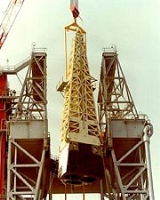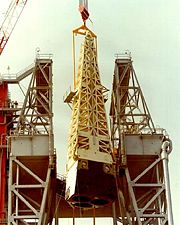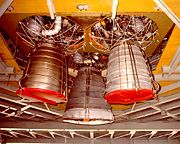
MPTA-098
Encyclopedia

Rockwell International
Rockwell International was a major American manufacturing conglomerate in the latter half of the 20th century, involved in aircraft, the space industry, both defense-oriented and commercial electronics, automotive and truck components, printing presses, valves and meters, and industrial automation....
as a testbed for the definitive propulsion and fuel delivery systems for the U.S. Space Shuttle Program
Space Shuttle
The Space Shuttle was a manned orbital rocket and spacecraft system operated by NASA on 135 missions from 1981 to 2011. The system combined rocket launch, orbital spacecraft, and re-entry spaceplane with modular add-ons...
.
Description
Never intended for actual spaceflight, the MPTA consisted of the internal structure of a Space ShuttleSpace Shuttle
The Space Shuttle was a manned orbital rocket and spacecraft system operated by NASA on 135 missions from 1981 to 2011. The system combined rocket launch, orbital spacecraft, and re-entry spaceplane with modular add-ons...
orbiter aft-fuselage
Fuselage
The fuselage is an aircraft's main body section that holds crew and passengers or cargo. In single-engine aircraft it will usually contain an engine, although in some amphibious aircraft the single engine is mounted on a pylon attached to the fuselage which in turn is used as a floating hull...
, a truss structure that simulated the basic structure and shape of an orbiter mid-fuselage and a complete Space Shuttle Main Engine
Space Shuttle main engine
The RS-25, otherwise known as the Space Shuttle Main Engine , is a reusable liquid-fuel rocket engine built by Pratt & Whitney Rocketdyne for the Space Shuttle, running on liquid hydrogen and oxygen. Each Space Shuttle was propelled by three SSMEs mated to one powerhead...
(SSME) assembly, including all main propulsion system plumbing and the associated electrical systems.
Later, the very different STA (Structural Test Article) was converted into a flightworthy orbiter, re-designated OV-099, and christened Challenger
Space Shuttle Challenger
Space Shuttle Challenger was NASA's second Space Shuttle orbiter to be put into service, Columbia having been the first. The shuttle was built by Rockwell International's Space Transportation Systems Division in Downey, California...
. Rockwell and NASA
NASA
The National Aeronautics and Space Administration is the agency of the United States government that is responsible for the nation's civilian space program and for aeronautics and aerospace research...
thus retroactively re-designated the MPTA as MPTA-098, though it was never christened with a name.
History
On June 24, 1977, MPTA-098 was delivered by Rockwell International to the National Space Technology Laboratory (NSTL), in Hancock County, MississippiHancock County, Mississippi
-Demographics:As of the census of 2000, there were 42,967 people, 16,897 households, and 11,827 families residing in the county. The population density was 90 people per square mile . There were 21,072 housing units at an average density of 44 per square mile...
, where it was mated with the Main Propulsion Test Article External Tank (MPTA-ET
MPTA-ET
The Main Propulsion Test Article External Tank was built by NASA to be used in conjunction with MPTA-098 for structural tests of the Space Shuttle Main Engines prior to construction of flyable craft...
), mounted in a launch orientation and used for static engine tests.
On July 2, 1979, MPTA-098 suffered major structural damage due to a fractured fuel valve on Space Shuttle Main Engine number 2002. The fracture allowed hydrogen to leak into the enclosed aft compartment, raising the pressure to beyond the structural capability of the heat shield supports, severely damaging the structure.
After extensive repairs were completed, testing resumed in September, but on November 4, a high-pressure oxidizer turbopump
Turbopump
A turbopump is a gas turbine that comprises basically two main components: a rotodynamic pump and a driving turbine, usually both mounted on the same shaft, or sometimes geared together...
failed 9.7 seconds into a scheduled 510-second test. Finally, on December 17, 1979, a complete static firing was accomplished that included all three Space Shuttle Main Engines running at up to 100 percent of rated thrust for 554 seconds, exceeding the predicted maximum time that the SSMEs would burn during an operational shuttle launch.
Flight certification
The preliminary flight certification (PFC) program, which would clear the way for the SSMEs to be flown aboard manned vehicles, began in early 1980. A number of setbacks, including an overheating high-pressure turbopump that shut down an engine 4.6 seconds into a 544-second test on April 16, 1980, in July, the burn-through of a hydrogen preburner cancelled a 581-second test after 105 seconds and the structural failureStructural failure
Structural failure refers to loss of the load-carrying capacity of a component or member within a structure or of the structure itself. Structural failure is initiated when the material is stressed to its strength limit, thus causing fracture or excessive deformations...
of a flight-rated nozzle shut down a November 1980 test after 20 seconds, slowed progress dramatically. These failures led to a number of critical changes to the SSMEs and their associated systems.
In June 1980, due to the number of changes in the SSME design since the SSME installation on Columbia
Space Shuttle Columbia
Space Shuttle Columbia was the first spaceworthy Space Shuttle in NASA's orbital fleet. First launched on the STS-1 mission, the first of the Space Shuttle program, it completed 27 missions before being destroyed during re-entry on February 1, 2003 near the end of its 28th, STS-107. All seven crew...
, the three flight-rated SSMEs (numbers 2005, 2006 and 2007) which had performed successful individual 520-second mission demonstration test firings on the NSTL SSME test stand in early 1979, were removed from OV-102, shipped to NSTL, and successfully recertified. The engines were then shipped back to Kennedy Space Center
Kennedy Space Center
The John F. Kennedy Space Center is the NASA installation that has been the launch site for every United States human space flight since 1968. Although such flights are currently on hiatus, KSC continues to manage and operate unmanned rocket launch facilities for America's civilian space program...
and reinstalled on Columbia.

STS-1
STS-1 was the first orbital flight of NASA's Space Shuttle program. Space Shuttle Columbia launched on 12 April 1981, and returned to Earth on 14 April, having orbited the Earth 37 times during the 54.5-hour mission. It was the first American manned space flight since the Apollo-Soyuz Test Project...
launch date, MPTA-098 successfully demonstrated a 625-second firing that included simulated abort profiles, completing the final PFC test and allowing the SSME design to be fully certified for flight, clearing the way for the launch of STS-1 on April 12, 1981.
Shuttle-C
From 1981 until 1988, the MPTA-098 and MPTA-ET remained in-situ on the NSTL test stand, unused. In late-1988, the Essex Corporation used the thrust structure of the MPTA as the basis for an engineering development model for the proposed Shuttle-CShuttle-C
The Shuttle-C was a NASA proposal to turn the Space Shuttle launch stack into a dedicated unmanned cargo launcher. This would use the Space Shuttle external tank and Space Shuttle Solid Rocket Boosters , combined with a cargo module that would attach to Shuttle hardpoints and include the Space...
launch vehicle. The model was used by NASA and Boeing at Kennedy Space Center
Kennedy Space Center
The John F. Kennedy Space Center is the NASA installation that has been the launch site for every United States human space flight since 1968. Although such flights are currently on hiatus, KSC continues to manage and operate unmanned rocket launch facilities for America's civilian space program...
and the Marshall Space Flight Center
Marshall Space Flight Center
The George C. Marshall Space Flight Center is the U.S. government's civilian rocketry and spacecraft propulsion research center. The largest center of NASA, MSFC's first mission was developing the Saturn launch vehicles for the Apollo moon program...
to conduct first-checks and manufacturing engineering studies. The Shuttle-C program was cancelled by the United States Congress
United States Congress
The United States Congress is the bicameral legislature of the federal government of the United States, consisting of the Senate and the House of Representatives. The Congress meets in the United States Capitol in Washington, D.C....
in the 1990 and the model was disassembled.
Present status
The Main Propulsion Test Article remains in storage at the National Space Technology Laboratory, now named the Stennis Space Center. The MPTA-ET is now located at the U.S. Space & Rocket Center, on the grounds of NASA's Marshall Space Flight CenterMarshall Space Flight Center
The George C. Marshall Space Flight Center is the U.S. government's civilian rocketry and spacecraft propulsion research center. The largest center of NASA, MSFC's first mission was developing the Saturn launch vehicles for the Apollo moon program...
, in Huntsville, Alabama
Huntsville, Alabama
Huntsville is a city located primarily in Madison County in the central part of the far northern region of the U.S. state of Alabama. Huntsville is the county seat of Madison County. The city extends west into neighboring Limestone County. Huntsville's population was 180,105 as of the 2010 Census....
where it is mounted under the refurbished "Pathfinder
Space Shuttle Pathfinder
- External links :* *...
" orbiter simulator.
Construction
- 07/26/72 Contract award
- 07/17/74 Start of long-lead fabrication
- 06/24/75 Start structural assembly of aft-fuselage
- 01/23/76 Truss on dock at RockwellRockwell InternationalRockwell International was a major American manufacturing conglomerate in the latter half of the 20th century, involved in aircraft, the space industry, both defense-oriented and commercial electronics, automotive and truck components, printing presses, valves and meters, and industrial automation....
DowneyDowney, CaliforniaDowney is a city located in southeast Los Angeles County, California, United States, southeast of downtown Los Angeles. The city is best known as the birthplace of the Apollo space program, and is the city where folk singer Karen Carpenter lived and died... - 03/17/76 Complete premate at DowneyDowney, CaliforniaDowney is a city located in southeast Los Angeles County, California, United States, southeast of downtown Los Angeles. The city is best known as the birthplace of the Apollo space program, and is the city where folk singer Karen Carpenter lived and died...
and delivered to PalmdalePalmdale, CaliforniaPalmdale is a city located in the center of northern Los Angeles County, California, United States.Palmdale was the first community within the Antelope Valley to incorporate as a city on August 24, 1962; 47 years later, voters approved creating a charter city in November, 2009. Palmdale is... - 05/03/76 Complete proof load test setup at PalmdalePalmdale, CaliforniaPalmdale is a city located in the center of northern Los Angeles County, California, United States.Palmdale was the first community within the Antelope Valley to incorporate as a city on August 24, 1962; 47 years later, voters approved creating a charter city in November, 2009. Palmdale is...
- 06/29/76 Move truss assembly from PalmdalePalmdale, CaliforniaPalmdale is a city located in the center of northern Los Angeles County, California, United States.Palmdale was the first community within the Antelope Valley to incorporate as a city on August 24, 1962; 47 years later, voters approved creating a charter city in November, 2009. Palmdale is...
Building 294 to 295 - 07/08/76 MPTA-098 on dock at DowneyDowney, CaliforniaDowney is a city located in southeast Los Angeles County, California, United States, southeast of downtown Los Angeles. The city is best known as the birthplace of the Apollo space program, and is the city where folk singer Karen Carpenter lived and died...
- 07/12/76 Start of Final Assembly
- 07/24/76 Complete MPTA-098 proof load test
- 05/27/77 Completed Final Assembly, Transport to Seal BeachSeal Beach, California-Neighborhoods:Seal Beach encompasses the Leisure World retirement gated community with roughly 9,000 residents. This was the first major planned retirement community of its type in the U.S...
- 06/03/77 Transport from Seal BeachSeal Beach, California-Neighborhoods:Seal Beach encompasses the Leisure World retirement gated community with roughly 9,000 residents. This was the first major planned retirement community of its type in the U.S...
to NSTL - 06/24/77 Arrival at NSTL for static firing
- 09/10/77 Arrival of MPTA-ETMPTA-ETThe Main Propulsion Test Article External Tank was built by NASA to be used in conjunction with MPTA-098 for structural tests of the Space Shuttle Main Engines prior to construction of flyable craft...
at NSTL
Test firings
- 04/21/78 1st static firing (2.5 sec)
- 05/19/78 2nd static firing (15 sec)
- 06/15/78 3rd static firing (50 sec)
- 07/07/78 4th static firing (100 sec)
- 05/04/79 5th static firing flight nozzles (1.5 sec)
- 06/12/79 5th static firing flight nozzles (54 sec)
- 10/24/79 6th static firing flight nozzles (scrubbed)
- 11/04/79 6th static firing flight nozzles (10 sec cutoff)
- 12/17/79 6th static firing non-flight (554 sec)
- 02/28/80 7th static firing non-flight (555 sec)
- 03/28/80 8th static firing non-flight (539 sec)
- 04/16/80 9th static firing non-flight (4.6 sec cutoff)
- 05/30/80 9th static firing non-flight (565 sec cutoff)
- 07/12/80 10th static firing flight nozzles (105 sec shutdown)
- 11/03/80 11th static firing flight nozzles (20 sec shutdown)
- 12/04/80 11th static firing non-flight (591 sec)
- 01/17/81 12th static firing flight nozzles (625 sec) http://science.ksc.nasa.gov/shuttle/resources/orbiters/mpta-098.html
See also
- Boilerplate
- MPTA-ETMPTA-ETThe Main Propulsion Test Article External Tank was built by NASA to be used in conjunction with MPTA-098 for structural tests of the Space Shuttle Main Engines prior to construction of flyable craft...
- Space Shuttle Main EngineSpace Shuttle main engineThe RS-25, otherwise known as the Space Shuttle Main Engine , is a reusable liquid-fuel rocket engine built by Pratt & Whitney Rocketdyne for the Space Shuttle, running on liquid hydrogen and oxygen. Each Space Shuttle was propelled by three SSMEs mated to one powerhead...

